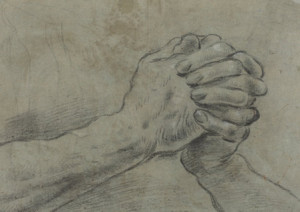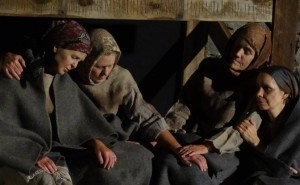

I certainly received it—a taste of hope—at The Ruin last weekend. The Ruin is a wondrously made outdoor environment built by Gabe and Sarah Acrich at their home in the Sierra foothills. Envision a very large living room, made of rock walls, minus the ceiling and fourth wall, so the space is open to the sky and fields. Now imagine that the walls slope downward, lined with tall glass votive holders, and pierced with niches, so the perimeter is dotted with candle light. Within this powerfully moving space, Sarah staged a play set in a Nazi concentration camp: Taste of Hope: A Play in Three Courses.
Hope and concentration camps might seem mutually exclusive. But the profound territory that this play explores is how hope was kept alive in a hopeless situation.
The Acrich’s have a personal connection to the Holocaust; Gabe’s grandfather survived Mauthjausen. When Sarah read In Memory’s Kitchen, A Legacy From the Women of Terezin, a nonfiction book based on recipes secretly collected in a Czech concentration camp, she was immediately inspired to work with that material, family material, and other Holocaust stories to create a play affirming the faith, strength, love, and courage of the women in the camps.
Sarah is a woman of extraordinary vision, creativity and energy. Not only did she write the play, create The Ruin, recruit talented actors and musicians (drawn from friends, students and family), she also cooked latkes, matzo ball soup, carmels and honey cake—recipes which the women discussed fervently in the camp. After each act, the audience was served a hearty taste of these dishes, which were now soaked in meaning, significance and wonder.
I was seated next to a Jewish woman. Her husband did not attend; Holocaust events are too raw for him. She, however, was delighted with the play, and during each course shared with me how she had learned to cook that dish, family variations in recipes, and memories of the holidays. I was thus privileged to experience the continuity that the women in the camp desperately longed for and dedicated themselves to insuring.
The play worked with the theme of continuity by having three areas always present on stage: a modern kitchen, with a contemporary mother and daughter cooking and occasionally talking; a kitchen from the pre-war era with a grandmother instructing a granddaughter; and the main focus of the bunks, where four starving women prisoners engaged in intimate dialogue. I would have found the concentration camp conversations almost too excruciating to bear, if not for the silent testimony of the past kitchen anchored in tradition and the modern kitchen witnessing to ongoing life. In this way, the play’s structure beautifully gave us a paradigm of time’s effect on suffering, evil, and healing.
In a further amplification of the themes of food, community, and hope, each performance was a fundraiser. There was no admission fee; all donations received went to hunger-relief organizations. The performance I attended was an Empty Bowl Project in support of the Gathering Inn, a private nonprofit serving the county’s homeless.
After the play, audience members lingered in the ruin, licking honey cake and carmels from our fingers. A slender moon hung overhead. “Puts things in perspective,” someone said. “Made me think about hope,” another affirmed. And then there was mostly the crunch of gravel as we made our way down the driveway, our flashlights flickering in the dark.
The sketch above is Giacomo Cavedone’s Clasped Hands, 1612, courtesy of the National Gallery of Art.
The photograph was taken during a performance.